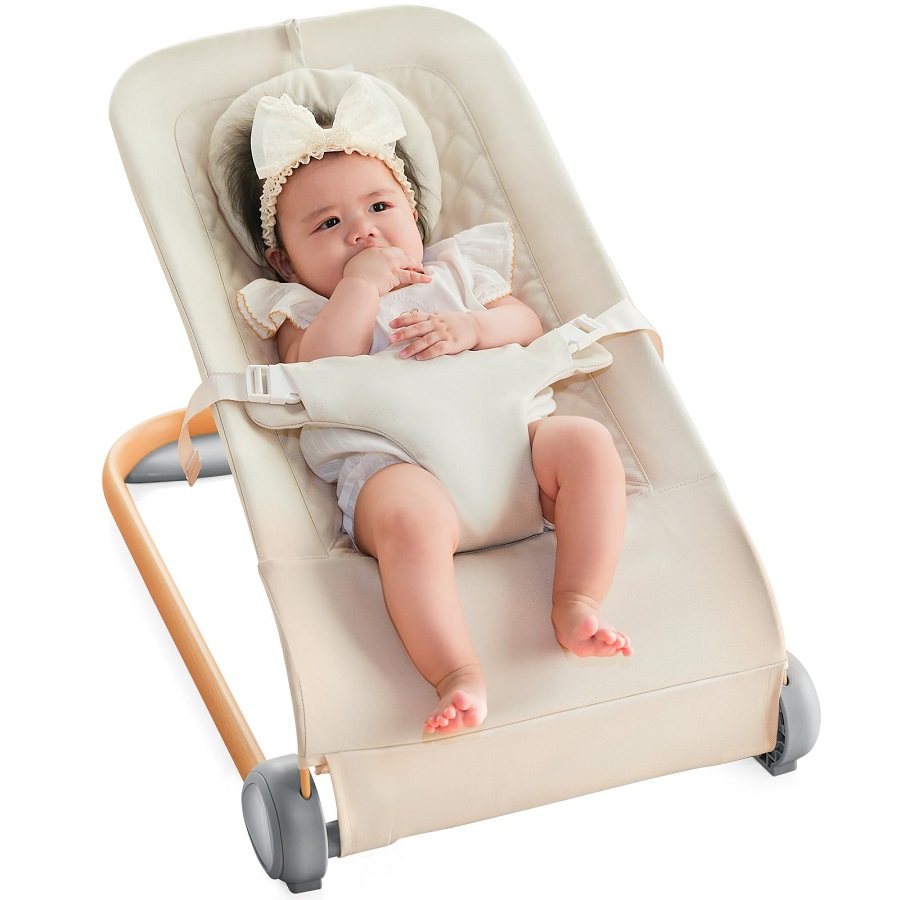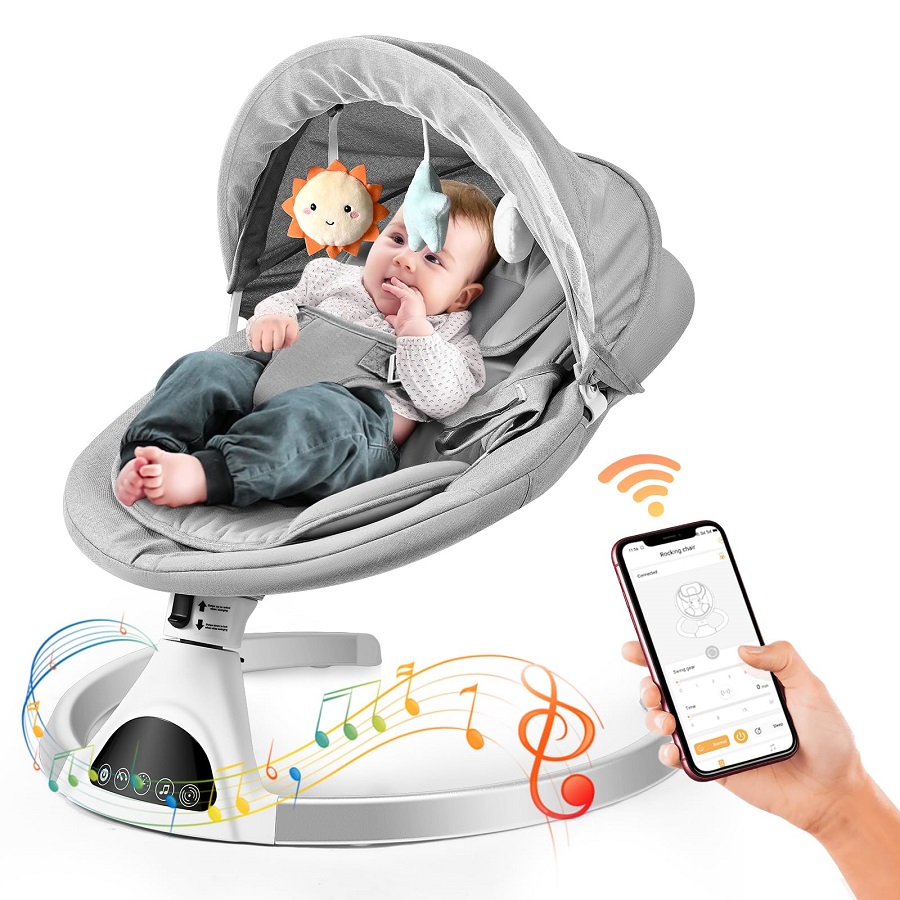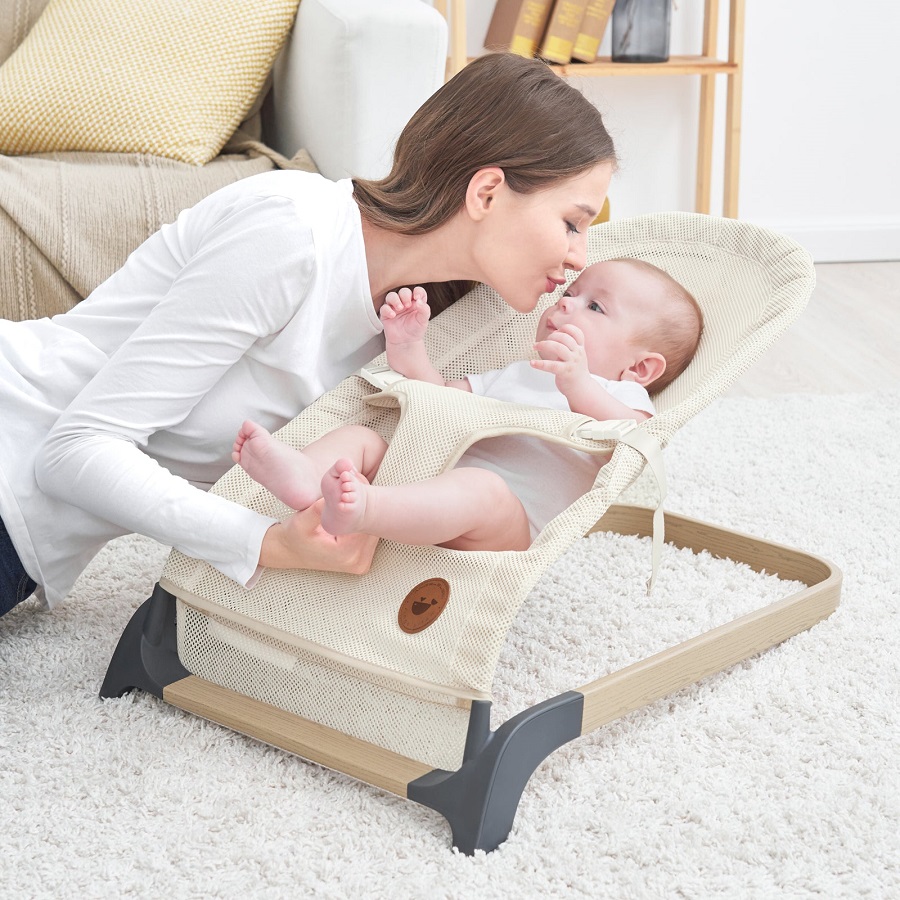Introduction to Baby Bouncer Safety
When it comes to your baby’s safety, every detail matters. Baby bouncers are popular for keeping little ones entertained. They are portable seats that bounce or rock. This can soothe your baby and sometimes even send them to sleep. But, is it safe for babies to sleep in them for nap time or during the night? Since safety is a big concern, let’s look at the facts around baby bouncers and sleep. The hard truth is, while bouncers can calm and entertain, they’re not meant for long sleep periods.
To keep your baby safe, always use a baby bouncer on the floor and not on raised surfaces. This prevents falls. Bouncers should have a safety strap. Always buckle up to stop your baby from slipping. Keep an eye on your baby. Never leave them alone in the bouncer. Also, remember to follow the guidelines from the manufacturer about weight and age for using a bouncer.
As a rule, baby bouncers are built for short bursts of use. They’re not for long periods of sleep. A crib or bassinet is safer for that. These offer a flat, firm surface for your baby to sleep on. They also keep your baby’s spine in the right position. It’s simple: bouncers entertain, cribs ensure safe sleep. We’ll dive deeper into these details and discuss how to make sure your baby sleeps safely and soundly. Let’s explore these topics one by one.

The Risk of Sudden Infant Death Syndrome (SIDS) When Sleeping in Bouncers
Sudden Infant Death Syndrome (SIDS) represents a crucial risk for babies sleeping in bouncers. The semi-upright position of bouncers can cause babies’ heads to tilt forward. This may block their airway which increases the risk of SIDS. Pediatric experts, including those from the American Academy of Pediatrics (AAP), advise against using bouncers for sleeping.
Bouncers do not provide a flat, stable surface which is essential for safe baby sleep. A flat surface helps maintain open airways. Parents should always transfer their baby to a crib or bassinet for sleep. This ensures the baby’s head remains in a safe position.
Supervision is vital if a baby dozes off in a bouncer. Immediately move them to a safer sleep environment. Keeping a vigilant eye ensures immediate action can be taken to prevent any risks. Always prioritize a baby’s safety over convenience or temporary quiet moments.
Appropriate Spinal Development and Sleep Surfaces
For a baby’s health, a flat, firm sleep surface is essential. This helps with spine growth. Baby bouncers don’t give this flat surface. They can cause poor posture and spinal problems. So, for sleep, use a crib or bassinet. These give the right support for your baby’s back and head.
Using bouncers for play is fine, but not for sleep. For sleep, ensure a flat and firm mattress in a crib. Keep your baby safe by choosing the right sleep surface. They will have better spinal development and safer sleep.
Hazards of Falling and Importance of Proper Bouncer Placement
Parents must guard against falling risks when using baby bouncers. As babies grow, they move more. This increases the chance of falling from a bouncer. Safety starts with correct bouncer placement. Here are key points to remember:
- Place the Bouncer on the Ground: A bouncer should always be on a stable, flat surface. High surfaces like tables can lead to falls.
- Away from Hazards: Keep the bouncer away from edges or sharp objects that could harm your baby.
- Out of Reach: Make sure items that might tempt your baby to reach out and grab, potentially causing the bouncer to tip, are not nearby.
- Proper Setup: Follow the setup instructions carefully to ensure the bouncer is stable.
Looking for safe spots for baby sleeping in bouncer moments is critical, but never use it as a substitute for a crib. If your baby falls asleep in a bouncer, move them to a safe sleep space right away. By making smart choices about bouncer placement and use, you can avoid potential injuries and provide a safer environment for your baby. Keep baby sleeping in bouncer only for short, supervised periods.

Guidelines for Supervised Bouncer Use
When using a baby bouncer, supervision is key to ensuring your baby’s safety. Below are some critical guidelines to adhere to during bouncer use:
- Always Monitor Your Baby: Never leave your baby alone when they’re in the bouncer. Attend to them at all times to quickly address any safety issues.
- Keep the Bouncer on Flat Ground: Always place the bouncer on a stable, flat surface. Elevated surfaces like tables or beds are off-limits to prevent tipping or falls.
- Use Safety Straps: Ensure your baby is securely strapped in the bouncer. This prevents them from slipping out or making unsafe movements.
- Regular Checks: Frequently inspect the bouncer for any damages or loose parts. Safety can be compromised by wear or mechanical faults.
- Time Limit: Limit the time your baby spends in the bouncer. Long periods can affect your baby’s posture and comfort.
Following these guidelines will help create a safer environment while your baby enjoys the bouncer. Remember, a bouncer is great for short, interactive sessions under close supervision, but it’s not a substitute for a crib or bassinet.
Manufacturer’s Weight and Age Recommendations
When using a baby bouncer, adhering to the manufacturer’s weight and age recommendations is crucial for your baby’s safety. Each bouncer comes with specific guidelines that you must follow to ensure optimal safety and functionality.
Weight Guidelines
Most bouncers are designed to support babies from birth up until they reach a certain weight. Commonly, this weight limit can be anywhere from 15 to 25 pounds. It’s paramount to never exceed the recommended weight as this can potentially compromise the bouncer’s structure and your baby’s safety.
Age Guidelines
In addition to weight guidelines, manufacturers also provide age recommendations. Typically, a bouncer is suitable for newborns and babies up to about six months old. The age limit is often set based on the baby’s development, such as the ability to sit up unassisted, which might lead to a higher risk of climbing or falling out of the bouncer.
Importance of Compliance
Following these guidelines is not just about adhering to rules—it’s about ensuring your baby’s safety while using the bouncer. Overlooking these recommendations could lead to accidents or discomfort for your baby. Always check the specific guidelines provided by your bouncer’s manufacturer and strictly adhere to them.
Using a baby bouncer safely means always keeping the limits in mind and being proactive about your baby’s growth. If your baby reaches the weight or age limit, it’s time to transition them out of the bouncer. Ensure their engagement and safety with suitable alternatives like a playpen or on-the-floor activities.
Safer Alternatives to Baby Bouncers for Sleep
Parents want the best for their baby’s sleep. A safe, cozy spot is key. Stand by these options:
- Baby Bedding Basics: A solid crib or bassinet tops the list. Flat and firm matters most.
- Room-Sharing Setup: Keep babies close but on separate beds. It’s safe and handy.
- Portable Cribs, Handy: Travel often? A portable crib works well. Keep safety in check.
- Baby-friendly Sleepwear: Use wearable blankets, not loose. Avoid any sleep risks.
Every choice should balance your baby’s comfort with safety. Stick to the AAP guidelines. Check weight and age limits before using any product. Keep baby sleeping in bouncers to a minimum. Always prioritize their well-being.

Creating a Safe Sleep Environment
Ensuring your baby’s sleep space is safe is a top priority. It’s crucial to create an environment that supports peaceful and secure sleep. Follow these steps to achieve this:
- Use Flat and Firm Mattresses: Babies should always sleep on flat, firm surfaces. Avoid soft, cushioned, or inclined sleeping aids, which can hinder breathing.
- Keep the Sleep Area Uncluttered: The sleep space should be free of toys, pillows, and loose bedding. These can pose suffocation risks.
- Select the Right Temperature: The room should be at a comfortable temperature. Dress your baby accordingly to prevent overheating.
- Room-Sharing is Recommended: This allows you to monitor your baby closely. Yet, the baby should have their own sleep surface like a crib or bassinet.
- Use Sleep Sacks or Sleepwear: Opt for wearable blankets or sleep sacks. These are safe and keep babies warm without the risks of loose blankets.
- Practice Safe Swaddling: If swaddling your baby, do it properly. Ensure it’s not too tight and that the baby can move their hips.
Remember, a safe sleep environment reduces the risk of SIDS and other sleep-related issues. Safety measures should always precede convenience or aesthetics. Your baby’s well-being is most important.
The Role of Parents in Sleep Safety and Emergency Preparedness
The safety of a baby’s sleep is largely up to the parents. It’s their role to make sure each sleep setting is secure. Parents should learn about potential sleep dangers. They need to make sure their baby sleeps safely. Here are key responsibilities for parents:
- Learn about SIDS: It’s serious, and awareness can prevent it. Parents should know the risks.
- Check the sleep area: Before bedtime, ensure everything is safe. No loose items or soft bedding.
- Be prepared for emergencies: Knowing what to do is crucial. Have a plan and first aid knowledge.
- Create a routine: Consistent bedtime means a safer environment. Set a schedule and stick to it.
- Always supervise: Never leave a baby asleep in a bouncer. Watch them closely.
In addition to these practices, being prepared is also vital. Here’s what to do:
- Learn infant CPR: Be ready to act in an emergency. Saving a life may be up to you.
- Keep emergency numbers handy: Write them down. Place them near your phone.
- Regularly practice safety drills: Be ready if an emergency happens. Run drills regularly.
Safety isn’t just about knowing; it’s doing. Always follow guidelines and remain vigilant. Your baby depends on you for their safe sleep.
Conclusion on Safe Baby Sleep Practices
Ensuring a baby’s safe sleep is vital. Baby bouncers can soothe and entertain, but not for sleep. Always prioritize a flat, firm sleep surface like a crib or bassinet. This reduces SIDS risks and supports spine health.
Bouncer use should be limited, closely monitored, and follow safety tips. Never leave babies unsupervised in bouncers. Use the harness and place the bouncer on the floor.
Compliance with manufacturer’s weight and age recommendations is essential. When babies outgrow these limits, move to safer play options.
For restful sleep, create a tranquil environment. Use blackout curtains, maintain a comfortable temperature, and dress babies appropriately. This ensures safety and sleep quality.
Parents play a crucial role in sleep safety. Stay informed, prepare for emergencies, and always supervise. Learn infant CPR and keep emergency contacts within reach.
In summary, baby bouncers are great for awake time, not sleep. Safety comes first, so use firm sleep surfaces and attentive care. This ensures your baby’s well-being and peace of mind for you.
